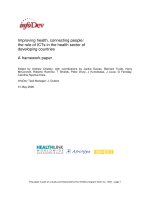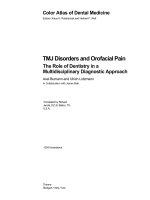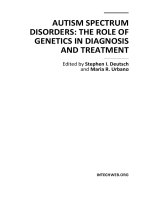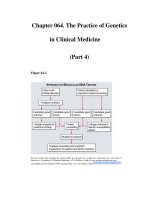THE ROLE OF SURGERY IN HEART FAILURE - part 3 pptx
Bạn đang xem bản rút gọn của tài liệu. Xem và tải ngay bản đầy đủ của tài liệu tại đây (214.31 KB, 2 trang )
across a prosthetic valve depends upon the type,
size, and position of the prosthesis as well as the
cardiac output; guidelines are available for the ac-
ceptable range of Doppler gradients encountered
in properly functioning valves. The ACC/AHA
guidelines [7] actually do not recommend an an-
nual routine echocardiography in patients who
have mechanical valves or during the first 5 years
with bioprosthetic valves unless there is a change
in clinical status. However patients who have bio-
prosthetic valves may be considered for annual
echocardiography after the first 5 years in the ab-
sence of a change in clinical status (IIb). An echo-
cardiography should be performed anytime if
there is a change in clinical status.
The most common prosthesis complications
are: extrinsic interference of function (pannus,
thrombus, vegetation) resulting in obstruction or
regurgitation, perivalvular leak, strut fracture and
component escape, leaflet tear of bioprosthesis,
and leaflet calcification/stenosis of bioprosthesis.
Because of its more anterior position, aortic
prosthesis can be imaged more efficiently by TTE
than mitral prosthesis. Assessment of mechanical
prosthetic malfunction is more difficult with TTE
because acoustic shadowing caused by the pros-
thetic material may limit transthoracic visualiza-
tion of prosthetic leaflets, vegetations, abscesses,
and thrombi. TEE should be performed when
TTE does not clearly identify the site and/or
Fig. 8. (A) Transesophageal echocardiogram of patient who had HeartMate vented electric LVAD showing volume un-
loading of left atrium and LV, whereas right-sided chambers remain volume loaded. ( B) Ex vivo LV end-diastolic pres-
sure–volume relations (EDPVR) measured from normal hearts, failing hearts, and end-stage failing hearts supported
with LVAD explanted at time of transplantation. (C) With heart size indexed by V30, volume on EDPVR at which pres-
sure is 30 mm Hg, it is seen that LV reverse structural remodeling occurs and is more prominent after than before 30 days
of support. In contrast, there is no significant reverse remodeling of right ventricle. (D) Time course of regression of cel-
lular hypertrophy during LVAD support. (From Mancini D, Burkhoff D. Mechanical device-based methods of manag-
ing and treating heart failure. Circulation 2005;112:444; with permission.)
133
EXPECTATIONS OF SURGEONS FROM AN IMAGER
Surgery for Heart Failure: Now Something
for Everyone?
Stephen Westaby, MS, PhD, FRCS
*
Oxford Heart Centre, John Radcliffe Hospital, Headington Oxford, UK
The year 2007 marks the 50th anniversary of
two major advances destined to become pivotal in
the treatment of heart failure. In 1957 Charles
Bailey reported a small series of left ventricular
aneurysm resections performed by side clamping
of the dyskinetic scar and suture without cardio-
pulmonary bypass. Performed with low mortality,
the operation provided immediate symptomatic
relief from breathlessness [1]. The same year, Wal-
ton Lillehei and Vincent Gott used direct electrical
stimulation of the myocardium to save a 3-year-
old child who had tetralogy of Fallot and
surgically induced complete heart block [2]. This
procedure was the landmark beginning of cardiac
pacing (Fig. 1).
For the past 50 years cardiac surgery has been
in a continuous state of flux. In congenital heart
disease palliative techniques have given way to
corrective operations using cardiopulmonary by-
pass. Rheumatic valve disease has virtually dis-
appeared with the widespread use of antibiotics.
Coronary artery bypass surgery (CABG) is in
recession with the hugely successful refinement of
percutaneous balloon angioplasty and stents. In
turn coronary intervention rates will fall because
of public health initiatives on diet and smoking
together with the widespread use of statins. Stent
graft technology now benefits many who would
otherwise require extensive high-risk thoracoab-
dominal aortic surgery. Total artificial hearts have
given way to left ventricular assist devices, and
pulsatile blood pumps are superceded by minia-
turized continuous flow devices. In the same way
that enthusiasm for prosthetic heart valves has
waned in favor of valve repair techniques, re-
construction of the failing heart is, for most
patients, a more realistic alternative than commit-
tal to a transplant waiting list.
Nontransplant heart failure surgery is an ex-
panding field at a time when medical treatment
and cardiac resynchronization therapy have rec-
ognized limits. Although donor hearts can be
supplied to only to a tiny minority of patients
who have heart failure, other surgical options may
soon provide symptomatic relief for the majority.
The demand for treatment emerges from an
increasingly elderly heart failure population with
greater expectations because of well-publicized
medical advances and rapidly evolving technology
[3]. The revolution in functional cardiac imaging
by three-dimensional echocardiography, magnetic
resonance, or contrast-enhanced computerized to-
mography has provided a much better under-
standing of the anatomy and pathophysiology of
heart failure. The failing heart beats at more
than 120,000 beats per day, pumping more than
6,000 L of blood against an increased systemic
and pulmonary afterload. As the heart dilates,
wall tension, myocardial energy, and oxygen con-
sumption increase. Subendocardial blood flow is
diminished in response. It is logical that a pharma-
cologically or mechanically unloaded heart has
the chance for recovery [4]. It is certain that the
remodeled and unsupported heart does not. Left
ventricular restoration surgery is predicated on
the well-defined relationship between cardiac
shape, volume, and function (Fig. 2) [5]. Equally,
the recent remarkable developments in blood
pump bioengineering provide an alternative ap-
proach and a platform on which to base genetic
or stem cell therapies [6].
* Oxford Heart Centre, John Radcliffe Hospital,
Headley Way, Headington, Oxford OX3 9DU, United
Kingdom.
E-mail address:
1551-7136/07/$ - see front matter Ó 2007 Published by Elsevier Inc.
doi:10.1016/j.hfc.2007.04.003 heartfailure.theclinics.com
Heart Failure Clin 3 (2007) 139–157









